Abstract
The article analyses foreign and Russian experience in the commercialization of scientific research results (SRR). It is concluded that the successful digitalization of the economy is based on the organic interaction of the triad "science-state-business", which provides an effective transfer of knowledge in the society. The purpose of the study is to determine the models of SRR commercialization, the most effective measures of state support and the forms of commercialization of innovations used in Russia and abroad, to identify factors that impede the digital transformation of Russian business. Research methods - statistical analysis of official data from various sources, including government agencies, official statistics bodies, universities, corporations, scientific centers and public organizations; methods of questioning, statistical processing and visualization of data; scientific synthesis and systematization of information. Results of the study. In the course of the analysis, it was established that in Russia, the number of small innovational enterprises (SIE) created for the commercialization of innovations decreased by 510 units, in 2017, as compared to 2011. A decrease in the state funding of Russian science, which is 0.36-0.58% of GDP, was noted. The factors preventing digital transformation of Russian business are identified, the main ones of which are technological incompetence of users (55% of respondents) and lack of experience in implementing digital projects (54%). The most effective foreign form of commercialization of innovations is determined - the spinouts.
Keywords: Scientific researchresults of intellectual activitymodels and forms of innovation commercializationdigital economy
Introduction
Currently, many foreign countries have come up with number of national programs and initiatives designed to stimulate the processes of digitalization of the economy. Only in the EU countries, according to official data of the European Commission in March 2017 there are more than 30 national and regional initiatives on industrial digitization (on digitizing industry). Not falling behind them the countries of East Asia - Japan, China, and South Korea. Some of these programs listed below (Oganesyan, Styrin, Abdrakhmanova, Rozmirovich, Merkulova, & Bikbulatova, 2017):
In the UK, approval of the national strategy of digitalization took place relatively recently which was named as “UK Digital Strategy 2017”. In the US, there is no national strategy focusing on the development of the digital economy, but there are separate federal initiatives, for example, on the development of cloud technologies, the creation of a new network of institutes / centers for advanced industrial production, etc.
In Russia, the program "Digital Economy of the Russian Federation" is implemented and approved by the Government Decree No. 1632-r on July 28, 2017, the main objectives of which are presented in Figure
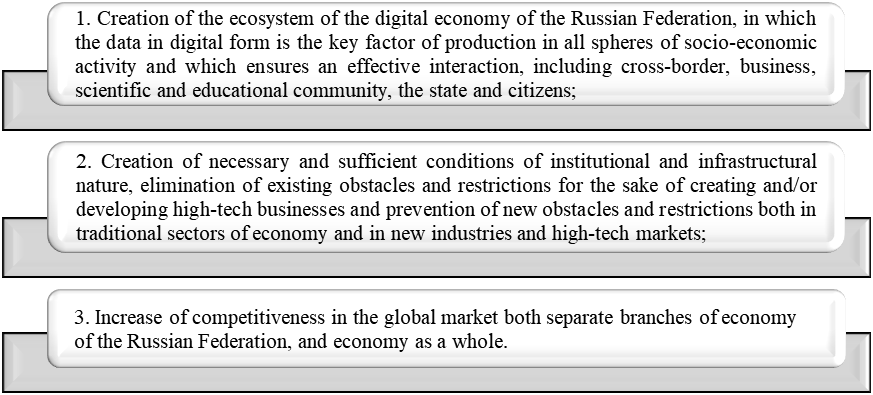
Targets of national program of Russia “Digital economy of Russian Federation”, 2017
Target analysis as well as content of provided programs indicates that transition to digital economy impossible without an effective transfer of knowledge within the society. As mentioned by the National Science Foundation (NSF) USA, transfer is a process by which technology or knowledge developed in one place or for one purpose, applied and used elsewhere for the same or another purpose. Scientific discoveries and inventions are embedded into economic activity through open dissemination (for example through scientific and technical literature, scientific exchanges) and market deals (for example patents licensing, official joint researches official joint research, providing protection of intellectual property, use of materials protected by copyright). Organizations within academic circles, federal government, businesses and non-profit sectors carry out events aimed at revealing new knowledge and technologies as well as providing support in their transfer for the sake of further application and commercialization of those as new products and processes. In addition to that, commercialization of the results of scientific research and intellectual activity is possible with the effective functioning of the triad “science-state-business” (Figure
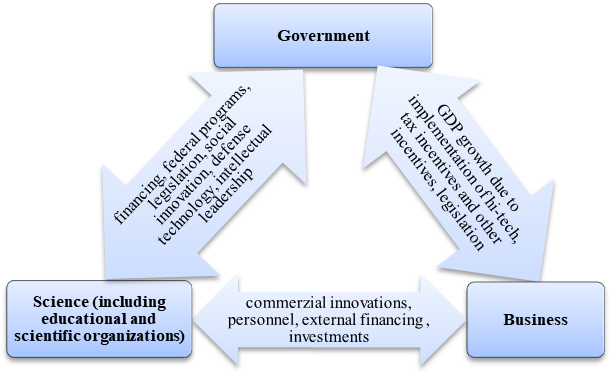
Science in face of educational and scientific organizations provides the government and businesses with new technology (defense, social, consumption and etc.), scientific staff, gives the business a competitive advantage and provides the country with the intellectual leadership in various fields (Barrell & Lemmens, 2015).
Furthermore, government financing scientific and research projects within universities, including the ones carried out in collaboration with businesses (for example in defense sector), legislatively regulates the intellectual property, tax incentives and etc. (Caiazza, 2016; Loseva, Fedotova, & Filimonova, 2016).
Businesses, on the other hand, receives a return on investment in science and through high-tech, production provides a significant increase in GDP, as well, as boosts its own competitiveness in domestic and world markets.
If the interaction of science, business and the state is effective, then at the output one can get impressive results. Thus, according to the Association of University Technology Managers (Analytical statement, 2017a), the following data confirm the efficiency of technology transfer in the US, which are recognized leaders in this matter at various stages of its life cycle (figure
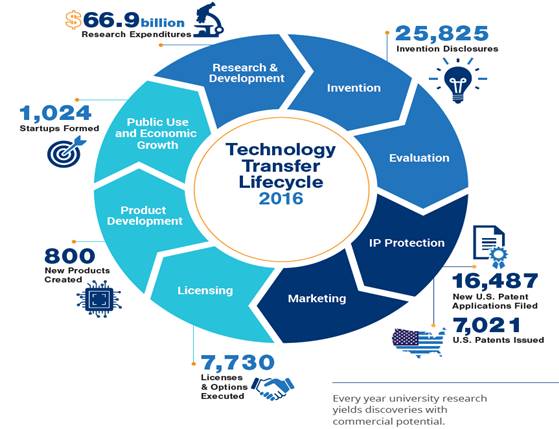
Summarizing the figure above:
Unfortunately, in Russia the transfer of knowledge is difficult due to various legislative, organizational and financial constraints. In this regard, the study of best practices of foreign countries and analysis of the existing difficulties in terms of commercialization of innovation and SRR is an urgent task, the solution of which will allow providing the necessary conditions for a successful transition to a digital economy.
Problem Statement
In the above triad, depending on the source of funding (budgetary or commercial), either the relationship "state-science" or the relationship "business science" comes to the fore. Within the first relationship, key measures are associated with state support for the transfer of knowledge through the creation of innovations, including SRR, received from budgetary funds in the framework of state contracts. Meanwhile, in the second relationship - the main role belongs to various forms of university entrepreneurship, focused on generating revenue from the commercialization of SSR in the external environment with the involvement of predominantly third-party investors from the business community. Thus, we should analyze:
1) Measures of state support provided by various countries for the transfer of knowledge in society, including, among other things, the commercialization of SRRs;
2) The infrastructure of results of research activity commercialization and university entrepreneurship in various countries, including forms of university entrepreneurship;
3) Factors hindering the digital transformation of business in Russia
Based on the analysis, it is necessary to determine the models and forms of SRR commercialization that will provide the necessary conditions for the transfer of knowledge in society and the successful transition to a digital economy.
Research Questions
The study aims to answer the following questions:
1) What are the sources and amounts of funding for research and commercialization of SRRs received in the US and European countries, including Russia;
2) What federal programs are implemented to stimulate and develop the commercialization of scientific research results in the US and European countries, including Russia;
3) Which basic models of SRR commercialization can be used in practice;
4) What are the most promising forms of university entrepreneurship;
5) Which factors that delay the digital transformation of business in Russia, are singled out by entrepreneurs themselves.
Purpose of the Study
Purpose of research - allocate models of commercialization of results of intellectual activity, the most effective actions from the government side in terms of support and forms of commercialization of innovations, applied in Russia and worldwide, identify factors, obstructing digital transformation of Russian business.
Research Methods
Statistical analysis of official data from various sources, including government authorities/agencies, official statistics bodies, universities, corporations, research centers and public organizations; methods of questioning, statistical processing and visualization of data; scientific synthesis and systematization of information.
Findings
Foreign experience shows that in many countries worldwide the problem of financing scientific research and their commercialization resolved at the state level.
In the USA, the National Science Foundation (NSF), with an annual budget of about $ 6 billion, and the US Department of Energy, NASA, the Ministry of Health and Social Welfare, are the main managers of the budget for research and development. Statistics on the funding of federal and private US universities from national funds are presented in Table
Note: Source: https://www.nsf.gov/statistics/2018/nsb20181/data/tables (Visit date 28.07.2018).
Summarizing table above it follows that the funding of the research in 2014-2016 had a positive dynamic, while expenditure of national universities was twice greater than in private universities.
Funding of academic scientific researches in Finland provided by Academy of Finland (2018), which functions within Ministry of education, science and culture. Annual volume of funding into scientific researches more than 260 mln. euros. Financing of applied scientific research with business community together with Ministry of Employment and Economics, which represented by Finnish Funding Agency for Technology and Innovation (TEKES). Annually, more than 60% of Finland’s innovation projects receive funding through this agency, including about 600 research projects in universities and research institutes, of which over 80% are statistically successful.
In France, in 2015, almost 2.23% of national budget was allocated on research and development, which amounted to 7.86 billion euros, of which 1.44% were provided by industrial enterprises and only 0.79% by the federal budget. Priority directions of budgetary financing are as follows: automobile industry, aircraft building, space research and pharmaceuticals (Analytical statement, 2017b).
There are two main sources of financing of scientific research in Germany at the state level:
The federal government, or more precisely, the federal ministries, which thus ensure the operation of about 38 scientific research institutes that create the required scientific basis for the solution of state-oriented targets;
Federal Lands, which act as funding sources for more than 100 regional research institutions.
In total, there are about 750 state-funded research institutions in Germany. In Russia, the funding of science for the period 2006-2016 according to the Federal State Statistics Service was between 2.14-2.87% of the federal budget (Figure

For comparison: the leading federal research universities in the US, in 2016, received $12.7 billion for research and development from the budgets of the National Institutes (Table
As can be seen in Figure
Maintenance of the results of scientific research commercialization, in the US, carried out through special federal programs operating in various industries. In particular, there is a program, implemented by the National Science Foundation (NSF) called Innovation Corps Program (I-Corps), aimed at the development of entrepreneurship, the purpose of which is the commercialization of technologies obtained through research funded by the NSF. The program provides entrepreneurial education for scientists and engineers, connecting them with business mentors to bring their results to a marketable product that is in demand. There are three separate components of I-Corps: teams, centers and sites that implement the complex of measures necessary for SRR commercialization. I-Corps teams include researchers funded by the NSF, who receive additional support - in the form of mentoring and funding – in order to accelerate innovation processes and attract further external funding. The centers are specially organized objects of educational and research infrastructure that support the I-Corps teams. I-Corps sites are academic institutes that catalyze the participation of their teams in the program, develop internal innovations and processes for creating their own SRR for their further commercialization.
In France, the National Center for Scientific Research (Analytical statement, 2016), under the administration of the Ministry of Higher Education and Scientific Research, plays an important role in the development of technology transfer. Its budget in 2014 was 3.29 billion euros. The key performance indicators of the CNRS are: € 18 million (excluding salary costs) allocated annually for the transfer of technology; 2 million euros annually allocated for the implementation of innovative projects; 2000 research contracts every year; 21 framework agreement with large corporations (EDF, Essilor, Safran, Thales, etc.); 1237 active licenses. The CNRS has established the Innovation and Business Relations Department (DIRE), which employs 300 professionals in the field of technology transfer. This department coordinates 18 centers of regional partnership and technology transfer and innovation departments, as well as supervises the activities of the support center for managing the patent portfolio. CNRS also cooperates with 14 state-owned technology transfer companies, in which it is a shareholder. The Agence d'Evaluation de la Recherche et de l'Enseignement Supérieur, established in France in 2006, is an independent administrative body that develops criteria and methodologies for assessing scientific research in need of state support.
In Finland, federal program for the creation of National Centers of Research, launched for 2014-2019 is successfully functioning. Furthermore, national development programs for research and development (R&D) adopted as instrument to implement innovative policies in various economic sectors. A solid example is the federal national program for the establishment of centers of expertise between 2007 and 2013 (The Center of Expertise Program), whose goal was to develop industry innovations in the form of special national clusters (digital business, biomedicine, energy technologies, forestry and food industry, tourism, etc.). Since 2008, TEKES has been working with the Academy of Finland on a public-private partnership basis to implement a federal program for the creation of Strategic Centers for Science, Technology and Innovation, which are unique platforms for cooperation between companies that innovate (including at the international level), with the scientific teams of Finnish universities. Currently, the following Centers operate on the principles of cluster entities: Open Dimecc Hightech Ecosystem (development of Internet technologies, digital services and creation of business ecosystems); SalWe Ltd (intellectual health monitoring), etc.
German federal government provide financial support for universities that are winners of the Excellence Initiative program, launched in 2006. In total, 4.6 billion euros had been allocated for this program between 2006 and 2017. The program made a significant contribution to overcoming the stagnation of research activities of universities and stimulated the development of new priority scientific areas. The most significant results of this program are:
1. International Postgraduate Studies (IGSSE) of the Technical University of Munich in the field of technology transfer for industrial and medical purposes;
2. Modeling technology (SimTech) of the University of Stuttgart in molecular dynamics, mechanics, interactive visualization, etc.;
3. The nanosystems of the University of Munich Ludwig-Maximilian in information, biotechnology, the use of solar energy, etc.
In Russia, the Foundation for Assistance to Small Innovative Enterprises in Science and Technology (Fund for Assistance to Innovation, 2018) successfully functions, the aims of which are presented in Figure
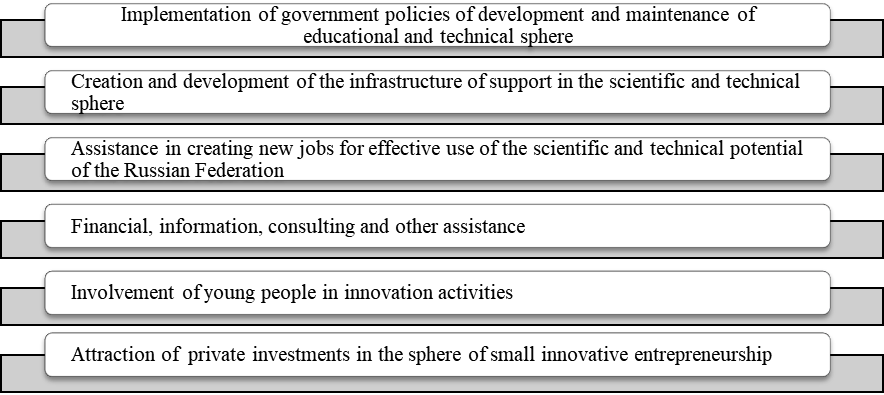
This fund implements, among others, the program "Commercialization", whose goal is to support small innovative enterprises that have completed R&D and plan to create or expand production of innovative products, as well as the "Development" program, aimed at commercializing the results of scientific and technical activities.
The Fund together with the Ministry of Economic Development of the Russian Federation provides state support to the Union of Innovation and Technology Centers (RUITCs) of Russia, whose main task is to facilitate the transfer and commercialization of Russian technologies abroad, which, since 2013, is part of the International Network for Small and Medium Enterprises Support (INSME). Additionally, the Fund concluded agreements on cooperation as well as scientific and technological cooperation between Russian SIEs and foreign organizations, including those with European Association of Development Agencies (EURADA), World Technopolis Association (WTA), etc.
In 2014, the Government of the Russian Federation adopted the state program of the Russian Federation "Development of Science and Technology" for 2013-2020, which includes, inter alia, the subprogram "Development of the sector of applied research and development" aimed at increasing the investment attractiveness of the sphere research and development for business. In addition, this program determines the priority areas for the development of Russia's scientific and technological complex.
Basic models of commercialization of the results of intellectual activity
While studying various features of the commercialization of the results of scientific research (RSS) in different countries, three basic models of commercialization of SRR have been identified, classified depending on the goals.
The first model (the model for generating revenue from the commercialization of the most successful SRRs) is oriented to the stable inflow of income from the scientific activities of the organization, which are formed by selling licenses for the most popular SRRs, from performing R&D in well-known competitive research areas of the university (scientific organization).
In this case, those employees of the university (scientific organization) responsible for the commercialization process concentrate their efforts on those SRRs that have the greatest commercial potential, paying insufficient attention to other less promising results. Often this leads to the fact that, first, the projects of those scientific teams that have already established themselves as successful authors of SRR are selected and supported. Intellectual property licensing specialists focus their efforts on them. This model works in large and medium-sized Russian and foreign universities, with the only difference that in large ones, the level of SRR can be international and national in nature, and in secondary ones, it is sectoral and regional.
In connection with the transition to the digital economy, intensification of SRR commercialization processes is required, which implies the identification of new potentially sought-after SRRs and increasing number of employees involved in their creation. In this regard, the second model of SRR commercialization is becoming topical, the purpose of which is to expand the range of related licensing services and provide organizational and financial support to all employees and creative teams focused on the creation of SRRs. All SRRs possessing at least any significant commercial (innovative) potential should be considered as sources of potential advantage, benefits (not only financial) and a chance for commercialization. All employees involved in the creation of the SRR provided with all necessary professional support on equal terms and at all stages of commercialization. In this case, the services for such professional support are financed by the allocation of a share in the royalty rate under a license agreement or in additional profits from the commercialization of the SRR. This practice used in many foreign universities, in particular, Purdue University (USA). The patent department of the university, when receiving an application from a scientist, provides the whole range of services for its support:
1.Assess the prospects for licensing and commercialization of the research project;
2.Prepares patents for intellectual property;
3.Searches for potential buyers, concludes transactions for the sale of intellectual property rights and prepares licensing agreements.
At the same time, 30% of revenue from royalties and other benefits transferred to the author, 30% goes to purchase the necessary equipment, and 10% represent overhead expenses of the patent department. The remaining 30% go to the Sowing Fund and provide additional funding to continue the university's research. Specialists of the patent department train employees in the basics of SRR commercialization, thereby attracting and retaining talented researchers with entrepreneurial abilities .
The third model of SRR commercialization (the model of university entrepreneurship) is oriented to the development of the business of an educational or scientific organization by:
More perspectives of university entrepreneurship and its forms will be considered later, in section
Infrastructure and the most perspective forms of universal entrepreneurship
In this section, we paid close attention to the interaction of educational and scientific organizations of different countries with business in the field of SRR commercialization (technology transfer) through the creation and operation of various objects of innovation infrastructure.
The transfer of technology by universities and other government research institutes, on the one hand, facilitates private sector access to research results, and on the other hand, it helps to solve the problem of lack of funding due to existing budget constraints.
One way to attract financial support from the private sector is the creation of a special bureau on technology transfer in scientific organizations and educational organizations. Such bureaus operate in the USA, Canada, Australia, Iran, Great Britain and some countries of the European Union (Guerrero & Urbano, 2010).
The AUTM Association, whose main goal is to support and promote university technologies around the world, annually accumulates data on the number (in percentage) of commercialized innovations through the Technology Transfer Bureau of various countries (Figure
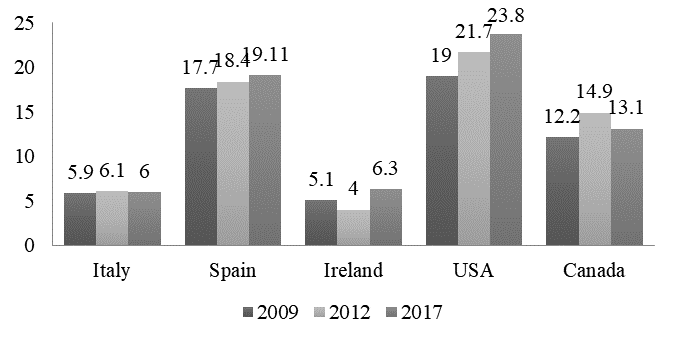
As can be seen from the data presented, the United States is the undisputed leader in the percentage of commercialized and all university innovations.
The emergence of "institutional and organizational resources" such as auxiliary commercial substructures, organizational incentives, a strong research base and access to venture capital, which formed a form of university entrepreneurship, was an important stage in increasing the effectiveness of the commercialization of scientific research results in scientific organizations and higher education organizations.
Initially, all types of commercialization activities under the category "university entrepreneurship" were beyond the usual commitments in the field of education and research (Di Gregorio & Shane, 2003). Universities used to be viewed as natural centers of development of scientific ideas with commercial and intellectual supporting structures that could be used to launch start-ups.
In fact, university entrepreneurship stimulated the innovative activity of teachers and students, going beyond the traditional implementation of grants for the creation of intellectual property objects and the definition of practical applications of side effects from knowledge and technology produced in universities.
At present, innovations and SRRs treated as the basis for the existence of any university. At the same time, the creation of the SRR necessarily involves their implementation in practice, through the sale of licenses, the production of new products or technologies, and the provision of new services. The implementation process carried out in the course of the entrepreneurial activities of the university and cooperation with the external environment (companies, other universities, professional associations, patent offices, etc.). There is a merger of science and business, which is reflected in the growth in the number of employees of the largest enterprises with academic degrees. In fact, enterprises become the largest employers of scientists and researchers. For example, in the US, the proportion of researchers holding a doctoral degree and employed in enterprises is 41% (U.S. S&E Workforce: Trends and Composition).
In the Russian Federation, as a subsidiary commercial sub-structure for the commercialization of the results of intellectual activity of scientific and educational institutions, a small innovative enterprise (hereinafter - SIE) is acting. The peak of their creation in universities was in 2011-2012, but now the number of their discoveries has significantly decreased (Figure
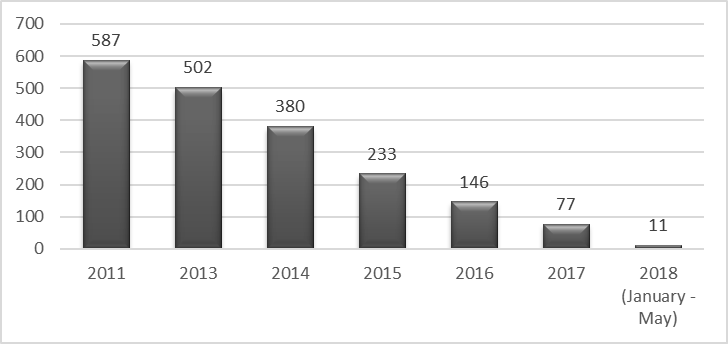
Furthermore, the macroeconomic effect from the creation of small innovative enterprises is still insignificant. However, they contributed to the growth of the level of practical use of the results of intellectual activity of scientific and educational institutions in the Russian Federation. So, if in 2011 no more than 10% of the protected intellectual property results were patented, and only 2.2% of the results of intellectual activity were commercialized (Kosourov, 2012), in 2017 more than 17% of the protected SRRs were patented, and about 15% of the results of intellectual activity were commercialized.
Currently, the most promising direction of the development of the commercialization infrastructure of SRR abroad is the creation of spinout, which engage in the implementation of commercially promising SRRs (Wright, Lockett, Clarysse, & Binks, 2006).
Spinning companies often organized in the form of a CJSC, in which 51% of the shares belong to the university, and the remaining 49% distributed to spinout participants as follows: management - up to 15%; the author of the idea - up to 15%, and the remaining shares - usually to venture investors (Hayter & Rooksby, 2016). The university backs of North America and Europe (Figure
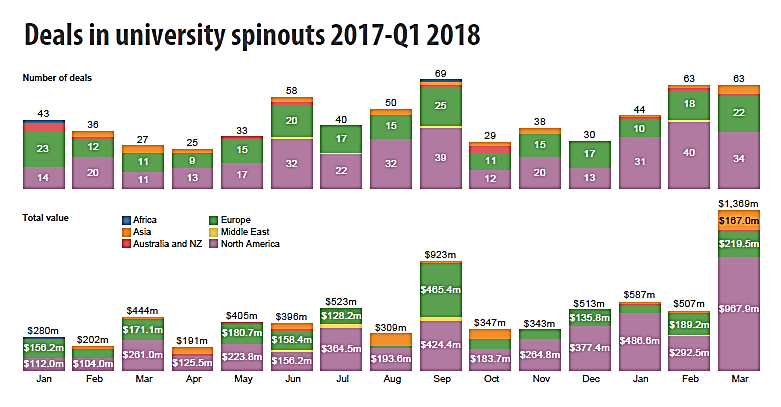
Figure indicates that the Asian spinouts often achieved the same successes or even surpassed the European spinouts by the cost of transactions (April, August, and October 2017). For the American spinouts the most commercially successful is March 2018 (income for investors has reached almost 1 billion US dollars).
Leadership for the creation of spinouts belongs to the universities of the United States and Great Britain. The University of California, Berkeley, Oxford and Stanford universities achieved the most significant successes. The total number of transactions concluded with university spinawats in 2017 has more than doubled compared to 2013 (Figure
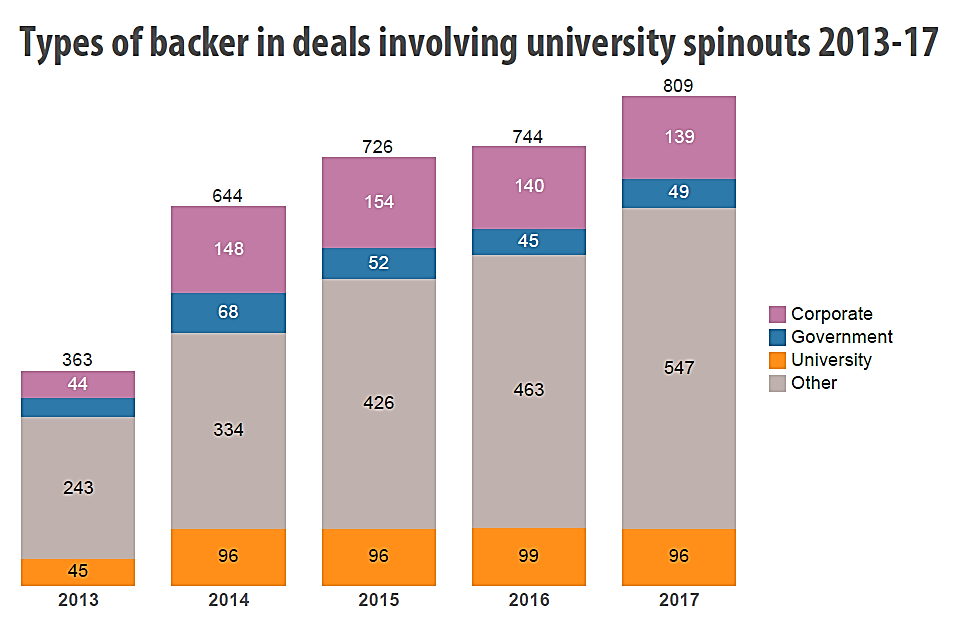
According to Anderson Law (Analytical statement, 2018), the law firm focusing on intellectual property – out of 10 spinouts that received private investment in the period of 2011-2015, 9 still exist and are developing, out of 10 start ups only 2 survived in five years. This indicates the promise of spinouts as a form of SRR commercialization. However, for Russian universities, the introduction of this form can be problematic, since the law on education does not provide for participation in joint-stock activities for state universities.
Factors hampering the digital transformation of business in Russia, in the opinion of entrepreneurs themselves
According to a survey of top managers of 80 Russian companies in the industrial, financial, IT and trade sectors, two groups of factors have been identified that adversely affect the success of digital business transformation (Figure
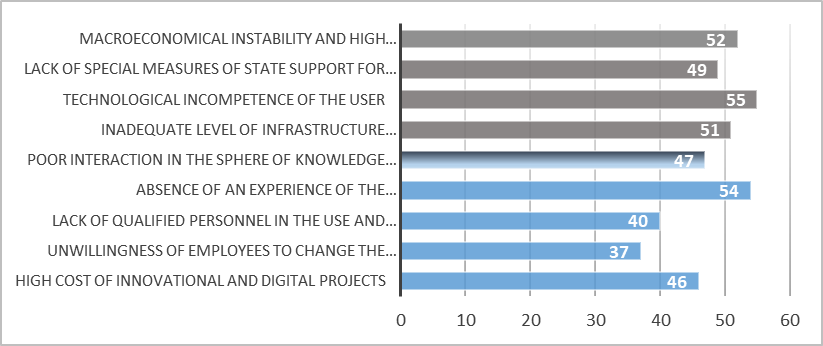
As can be seen from the figure, the greatest concern is the technological incompetence of users (55% of respondents), in addition to macroeconomic instability and intra-economic risks. Their unwillingness to perceive innovations, including in the field of digital technologies and lack of experience in the commercialization of SRRs and the implementation of digital projects (54% of respondents). Also, about half of the entrepreneurs mentioned the insufficient level of development of the infrastructure for the introduction of digital technologies and the commercialization of innovations (51%), as well as the lack of special measures of state support for the development and introduction of digital technologies (49%) and poor interaction in the sphere of knowledge transfer and technology transfer between the company and the external environment (47%), i.e. insufficiently effective functioning of the "science-state-business" triad.
Conclusion
Thus, the identified factors hampering the digital transformation of Russian business relate to problems in the transfer of knowledge and the interaction of the triad "science-state-business". The analysis of foreign and Russian experience in the field of commercialization of scientific research results and SRR will allow to ensure in the future the necessary conditions for the transition to a digital economy and the successful implementation of the federal program of the Russian Government "Digital Economy of the Russian Federation" for 2017-2020.
Acknowledgments
This research completed as the part of the State task of Financial University in 2018, Russian Foundation for basic research in 2018.
References
- Analytical statement. (2016). Advisory Committee Report (CNRS). Retrieved from URL: http://www.cnrs.fr/en/node/124.
- Analytical statement. (2017a). AUTM Licensing Activity Survey (Association of University Technology Managers). Retrieved from URL: https://www.autm.net/resources-surveys/research-reports-databases/licensing-surveys/
- Analytical statement. (2017b). Etapy razvitiya sistemy vyschego obrazovaniya Frantsii (Expert Center for European Studies). Retrieved from URL: http://www.spbstu.ru/international-cooperation/expert-center-international-cooperation/country-features/france/. [in Rus.].
- Analytical statement. (2017b). Review and funding decisions (Agency for the Evaluation of Scientific Research and Higher Education). Retrieved from URL: http://www.aka.fi/en/about-us/.
- Analytical statement. (2017c). Parution du rapport d’activité 2017 du Hcéres (Hércès). Retrieved from URL: http://www.hceres.fr/.
- Analytical statement. (2018). IU reveals 2017-18 results (Global University Venturing). Retrieved from URL: http://www.globaluniversityventuring.com/
- Barrell, K., & Lemmens, W. (2015). The future of digital services delivery embracing co-dependency for growth of the national digital economy. Australian Journal of Telecommunications and the Digital Economy, 3(3), 31-46.
- Caiazza, R. (2016). A cross-national analysis of policies affecting innovation diffusion. Journal of Technology Transfer, 41(6), 1406-1419.
- Di Gregorio, D., & Shane, S. (2003). Why Do Some Universities Generate More Start-ups than Others? Research Policy, 32, 209–227.
- Guerrero, M., & Urbano, D. (2010). The development of an entrepreneurial university. The Journal of Technology Transfer, 37, 43-74. DOI: 10.1007/s10961-010-9171-x.
- Hayter, C.S., & Rooksby, J.H. (2016). A legal perspective on university technology transfer. Journal of Technology Transfer, 41(2), 270-289.
- Kosourov, V. (2012). Reforms of legislation on intellectual property will stimulate innovative activity of business. ECO, 11. Retrieved from URL: http://ecotrends.ru/archive/627-edition-11 / 1450-2012-09-11-06-32-30.
- Loseva, O., Fedotova, M., & Filimonova, N. (2018). Methods for Measuring of Regional Intellectual Capital. Information, 19 (6A), 1771-1785.
- Oganesyan, T, Styrin, E, Abdrakhmanova, G, Rozmirovich, S, Merkulova, D., & Bikbulatova, Yu. (2017). Digital economy: global trends and the practice of Russian business. Russia, Moscow: HSE.
- Wright, M., Lockett, A., Clarysse, B., & Binks, M. (2006). University spin-out companies and venture capital. Research Policy, 35, 481– 501.
Copyright information

This work is licensed under a Creative Commons Attribution-NonCommercial-NoDerivatives 4.0 International License.
About this article
Publication Date
20 March 2019
Article Doi
eBook ISBN
978-1-80296-056-3
Publisher
Future Academy
Volume
57
Print ISBN (optional)
-
Edition Number
1st Edition
Pages
1-1887
Subjects
Business, business ethics, social responsibility, innovation, ethical issues, scientific developments, technological developments
Cite this article as:
Bakulina, A., Loseva, O., Raeva, I., & Kalinkina, K. (2019). Analysis Of International Experience In The Commercialization Of Scientific Research Results. In V. Mantulenko (Ed.), Global Challenges and Prospects of the Modern Economic Development, vol 57. European Proceedings of Social and Behavioural Sciences (pp. 426-441). Future Academy. https://doi.org/10.15405/epsbs.2019.03.43

